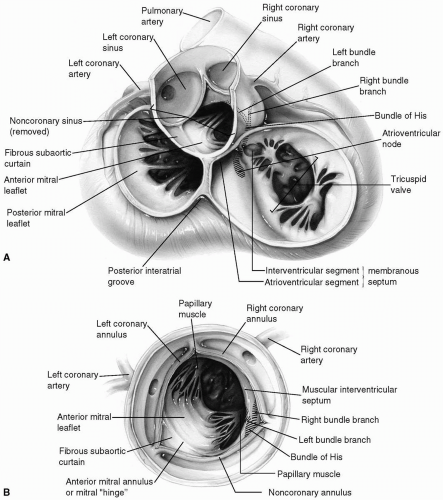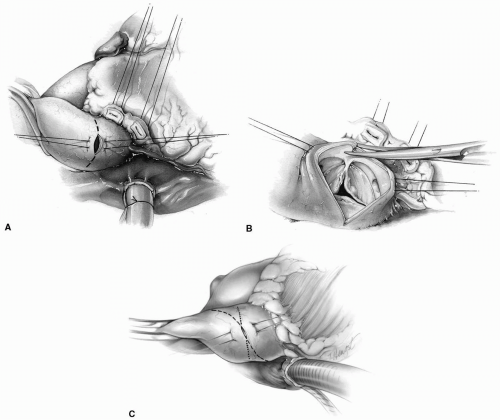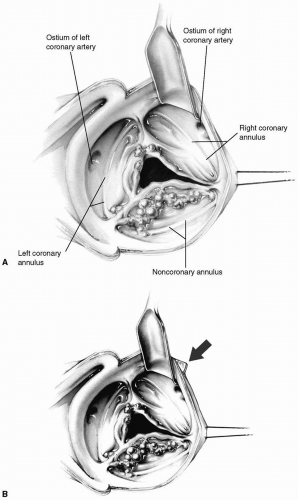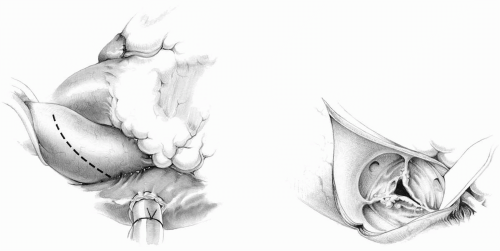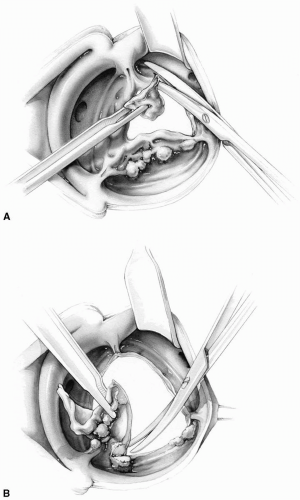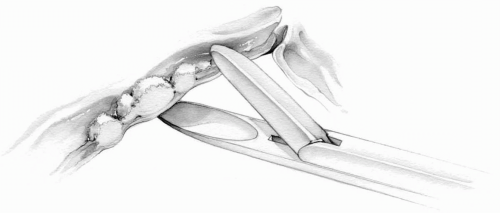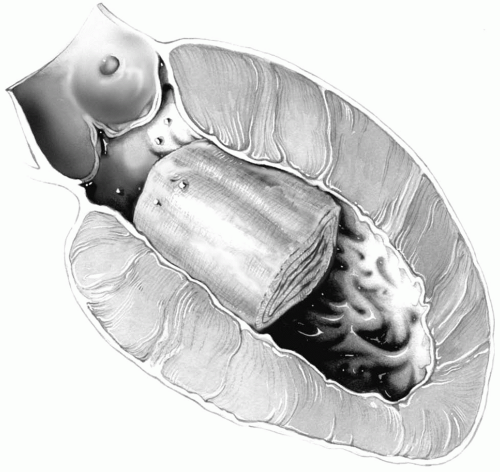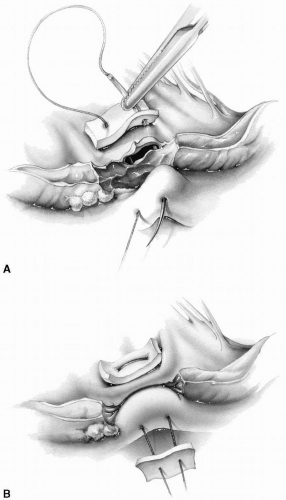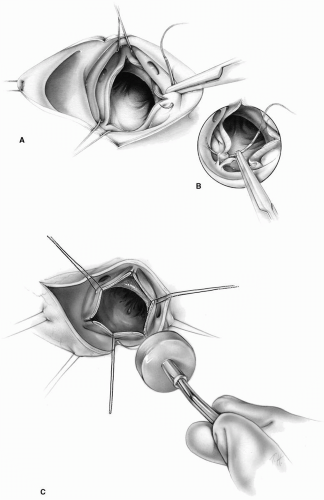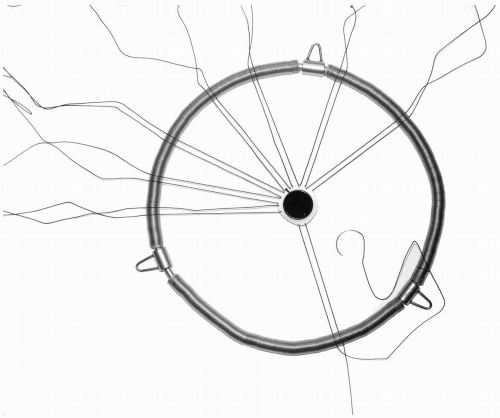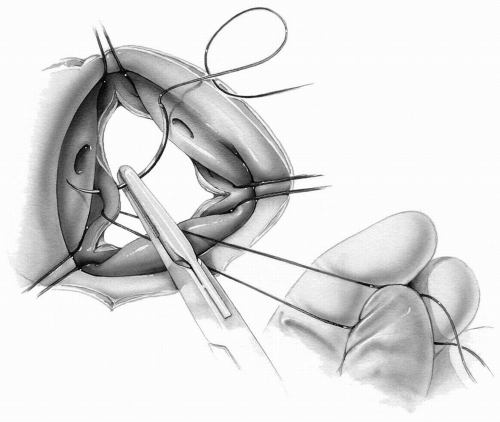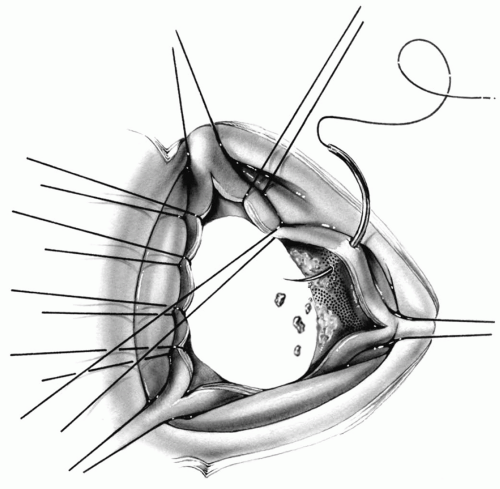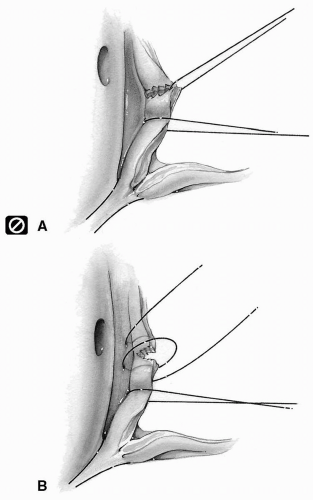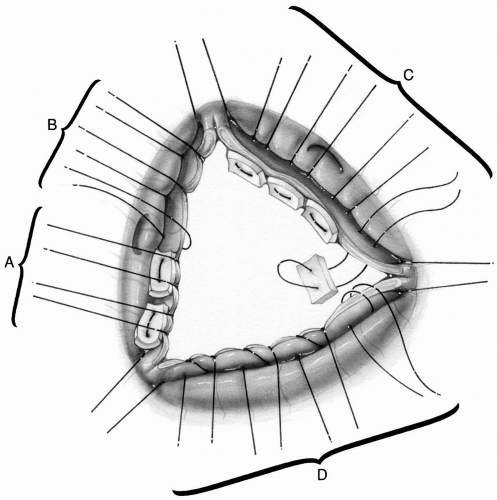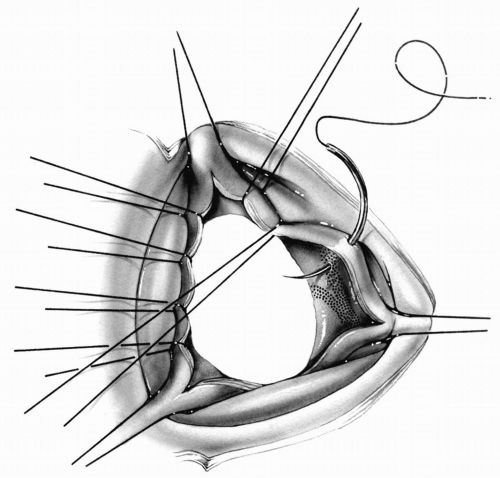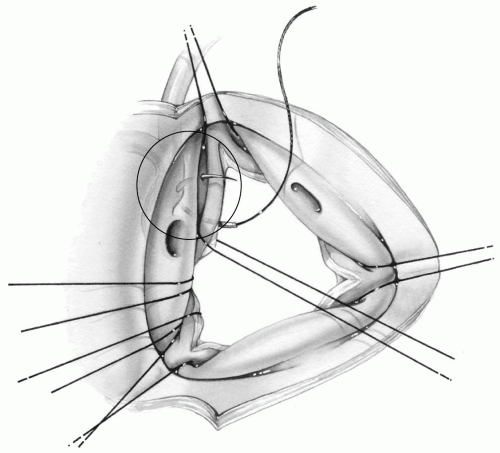Surgery of the Aortic Valve
Aortic stenosis secondary to degenerative calcification, congenital bicuspid aortic valve disease, or rheumatic fever is the most common indication for aortic valve replacement. Acute aortic insufficiency as a result of aortic dissection, endocarditis, or balloon valvuloplasty, requires urgent surgical intervention. Chronic aortic valve regurgitation caused by the slow enlargement of the aortic root or dysfunction of the valve cusps is seen with congenital abnormalities, most commonly bicuspid aortic valve, as well as rheumatic disease, endocarditis, calcific cusp degeneration, and degenerative aortic wall disease. The timing of surgery is important to prevent irreversible left ventricular dysfunction.
Surgical Anatomy of the Aortic Valve
The aortic valve has three cup-shaped leaflets or cusps: the noncoronary cusp, the left cusp, and the right cusp. These spring from three crescent-shaped valvular annuli within the expanded sinuses of Valsalva. The plane of the aortic annuli forms the line of demarcation between the left ventricular cavity and the aorta.
Attachments of the aortic valve to the left ventricular outflow tract are both muscular and membranous (Fig. 5-1). The three fibrous annuli are all associated with somewhat different structures. The noncoronary annulus is singular in that it does not give rise to a coronary artery and is attached to the left ventricle only by membrane. Adjoining halves of the left and noncoronary annuli and the small area beneath the intervening commissure, the fibrous subaortic curtain, are continuous with the anterior leaflet of the mitral valve. Below the noncoronary and right coronary annuli and the intervening commissure lie the central fibrous body and the membranous septum, which are divided into atrioventricular and interventricular segments by the contiguous attachment of the nearby tricuspid valve. This membrane usually circles under the noncoronary annulus and merges with the anterior leaflet of the mitral valve. The bundle of His passes into the muscular ventricular septum just below the membranous septum before dividing into left and right bundle branches. These travel inferiorly and downward along the medial side of the left ventricular outflow tract. This conduction tissue is, therefore, close to portions of the noncoronary and right coronary annuli. Behind the noncoronary sinus, and in direct opposition to it, are the interatrial groove and parts of the left and right atria (thus explaining the rupture of an aneurysm of the noncoronary sinus of Valsalva into these cavities).
Part of the right coronary annulus, as mentioned earlier, is directly attached through the central fibrous body to the muscular septal wall. It courses along the right ventricular outflow tract, merging at its commissure with the left coronary annulus adjacent to the pulmonary valve annulus. The right coronary artery originates from the upper part of the right coronary sinus of Valsalva and courses down the right atrioventricular sulcus. The left or anterior segment of the left coronary annulus underlies the only part of the aortic root not related to any of the cardiac chambers. The right or posterior half of the left coronary annulus is in apposition to the left atrium. The left main coronary artery arises from the upper part of the left sinus and runs a short but variable distance behind it before dividing into its branches.
It is important to understand the functional anatomy of the aortic valve when considering valve repair or valve preserving aortic root procedures. The aortic root consists of four components: the aortic annulus, the aortic cusps, the sinuses of Valsalva, and the sinotubular junction. The aortic annulus is attached to the interventricular septum and fibrous structures along 55% of its circumference, with the remaining 45% being attached to the ventricular myocardium. The aortic cusps have a semilunar shape and the length of the base is normally 1.5 times the length of the free margin. The commissure is the highest point where two cusps meet, which is just below the sinotubular junction. The annulus has a scalloped shape, and the diameter of the annulus in younger individuals is normally 15% to 20% larger than the diameter of the sinotubular junction. In older patients, these two diameters are nearly equal. The average length of the free margin of an aortic cusp is 1.5 times the diameter of the sinotubular junction. In general, the noncoronary cusp is slightly larger than the other two, and the left is the smallest.
Approach to the Aortic Valve
Aortic valve surgery can be performed through a median sternotomy with a full or limited skin incision, or using an upper ministernotomy (see Chapter 1). The distal ascending aorta is normally cannulated directly and a dual-staged venous cannula is placed into the right atrium. In cases with diffuse calcific or atherosclerotic involvement of the aorta or with aortic dissection, the arterial cannulation may need to be altered, and the conduct of the procedure modified (see Management of Unclampable Aorta).
Myocardial Preservation
Detailed techniques for preservation of the myocardium have already been discussed in Chapter 3. A modified synchronized technique for myocardial protection has been used in our practice for valvular surgery, particularly for aortic valve disease.
Technique
With a retrograde cardioplegic cannula in place in the coronary sinus and an antegrade cannula in the aortic root, cardiopulmonary bypass is initiated and moderate
hypothermia (28°C to 30°C) is achieved. The aorta is clamped, and 1,000 mL of cold blood cardioplegic solution (4°C to 8°C) is administered into the aortic root (see Chapter 3). Myocardial activity ceases, and electrocardiographic monitoring reveals a flat line.
hypothermia (28°C to 30°C) is achieved. The aorta is clamped, and 1,000 mL of cold blood cardioplegic solution (4°C to 8°C) is administered into the aortic root (see Chapter 3). Myocardial activity ceases, and electrocardiographic monitoring reveals a flat line.
Antegrade administration of blood cardioplegic solution into the aortic root can be satisfactorily accomplished only if the aortic valve is relatively competent (see Chapter 3). Presence of significant aortic valve insufficiency results in backflow of the cardioplegic solution into the noncontracting left ventricular cavity. This causes left ventricular distention and possible myocardial injury. Therefore, when the aortic valve is incompetent, the blood cardioplegic solution should be administered using a retrograde technique to achieve complete cardiac standstill. In addition, a left ventricular vent should be placed through the right superior pulmonary vein. Myocardial protection can be augmented by administering cardioplegic solution into the coronary ostia after the aorta has been opened.
Rarely, the retrograde cannula cannot be introduced safely into the coronary sinus. Bicaval cannulation is performed, and the retrograde cannula in placed in the coronary sinus under direct vision (see Chapter 3).
Cardioplegic arrest of the heart using a retrograde technique alone may at times be slow, particularly when the heart is enlarged. In these cases, aortotomy should be performed and cardioplegic solution administered directly into the coronary arteries.
The aortic leaflets may become so deformed because of calcific deposits that they physically obstruct cannulation of the coronary arteries and prevent satisfactory administration of blood cardioplegic solution. In this case, the left coronary cusp should be quickly excised to facilitate direct cannulation and infusion of blood cardioplegic solution into the left coronary ostium. Infusion into the right coronary artery can be performed when the heart has been arrested and the diseased aortic valve has been excised.
Cold blood cardioplegia is administered (usually every 10 minutes) in a retrograde manner to ensure the complete cessation of electrical activity of the myocardium. Between cardioplegia doses, cold oxygenated blood is continuously infused through the retrograde cannula whenever clear visualization of the aortic root is not required (such as placement of valve sutures in the sewing ring of the prosthetic valve). For optimal protection of the right ventricle, direct infusion of blood cardioplegic solution into the right coronary artery is carried out every 20 minutes, and ice wrapped with gauze is placed topically on the heart to minimize surface rewarming.
When the aortic valve has been seated and the valve sutures are being tied, the patient is rewarmed. Retrograde infusion of cold blood or cold blood cardioplegic solution through the coronary sinus is continued to ensure a complete cessation of myocardial activity. When the aortotomy closure is started, warm blood is infused retrogradely through the coronary sinus. Often concurrent with closure of the aortotomy, normal cardiac activity is observed. If the patient has undergone concomitant coronary artery bypass grafting, blood cardioplegia or cold blood can be infused simultaneously antegradely through the vein grafts and retrogradely through the coronary sinus.
Infusion of warm blood using the retrograde technique is continued for several minutes after the cross-clamp is removed to minimize the risk of air bubbles trapped in the aortic root entering the right coronary artery.
Exposure of the Aortic Valve by Transverse Aortotomy
A low transverse incision is perhaps most commonly used and is preferred by many surgeons (Fig. 5-2). The epicardial fat and adventitial tissue from the right ventricular outflow tract and pulmonary artery may overlie the desired line of aortic incision. These can be dissected free and retracted with a few pledgeted sutures (Fig. 5-2A). Fine Prolene sutures are inserted in the adventitia of the aortic wall on each side of the proposed incision line, which should be 10 to 15 mm above the origin of the right coronary artery. When the ascending aorta has been cross-clamped, the aortic wall is incised for a short distance between these sutures. A small leaflet retractor is introduced into the lumen of the aorta to expose the aortic valve.
Often the aortic wall is dilated and thinned out, particularly in elderly patients with poststenotic dilation. Aggressive traction may result in a transverse tear of the wall of the aortic root (Fig. 5-3). This may necessitate replacement of the ascending aorta or patch repair of the aortic wall.
Under direct vision, the opening is then extended on both sides; care must be taken to stay approximately 10 mm
above the aortic commissures (Fig. 5-2B). Alternatively, the incision can be extended obliquely upward and/or downward, converting it to an oblique incision or tailoring it to provide optimal exposure (Fig. 5-2C, dashed line).
above the aortic commissures (Fig. 5-2B). Alternatively, the incision can be extended obliquely upward and/or downward, converting it to an oblique incision or tailoring it to provide optimal exposure (Fig. 5-2C, dashed line).
Poststenotic dilation, which is commonly seen in patients with aortic stenosis and congenital bicuspid aortic valve, may distort the aortic root and cause upward displacement of the ostium of the right coronary artery. The usual transverse aortotomy may then be too low and impinge on the right coronary ostium. Care must be exercised in these patients to identify the origin of the right coronary artery before opening the aorta.
Exposure of the Aortic Valve by Oblique Aortotomy
An oblique or hockey-stick incision is started high on the medial aspect of the aorta and is then continued diagonally downward into the noncoronary sinus stopping 10 mm above the aortic annulus. The aortic walls are then retracted on each side (Fig. 5-4). This incision is particularly useful in patients with small aortic roots.
The lower limit of the incision should be well above the aortic annulus to avoid difficulty in placing sutures in the annulus for insertion of the prosthesis. This will also facilitate the aortic closure.
Epicardial fat overlying the right ventricle is very friable and if traumatized can develop into a large hematoma in heparinized patients. The epicardial fat can be gently retracted away from the operative field with pledgeted traction sutures (Fig. 5-2A).
Aortic Valve Replacement
Valve replacement is required in nearly all patients with aortic stenosis and many patients with aortic insufficiency. The choice of replacement valve depends on the patient’s age, concomitant disease, lifestyle, and anatomic factors. Contemporary mechanical valves include bileaflet
and tilting disc valves, which normally do not require rereplacement, but do require anticoagulation and have a higher risk of thromboembolic events. Stented bioprostheses include bovine pericardial and porcine valves that perform well without the need for anticoagulation for a number of years, but do experience structural deterioration and require reoperation. Stentless bioprosthetic valves offer better hemodynamics, especially in smaller valve sizes, but are technically more demanding to implant and undergo degenerative changes leading to valve rereplacement surgery. Aortic homografts have advantages similar to stentless valves and are usually more durable, but availability is a problem. The pulmonary autograft is the best replacement option for infants and children, offering growth potential and long-term freedom from reoperation on the aortic valve. However, it is a two-valve procedure with a need for reintervention on the pulmonary replacement valve.
and tilting disc valves, which normally do not require rereplacement, but do require anticoagulation and have a higher risk of thromboembolic events. Stented bioprostheses include bovine pericardial and porcine valves that perform well without the need for anticoagulation for a number of years, but do experience structural deterioration and require reoperation. Stentless bioprosthetic valves offer better hemodynamics, especially in smaller valve sizes, but are technically more demanding to implant and undergo degenerative changes leading to valve rereplacement surgery. Aortic homografts have advantages similar to stentless valves and are usually more durable, but availability is a problem. The pulmonary autograft is the best replacement option for infants and children, offering growth potential and long-term freedom from reoperation on the aortic valve. However, it is a two-valve procedure with a need for reintervention on the pulmonary replacement valve.
Excision of the Aortic Valve
The diseased valve leaflets are excised with scissors, leaving a 1- to 2-mm margin at the annulus (Fig. 5-5). The calcified segments of the annulus are crushed between pituitary rongeurs, and the calcium fragments are gently milked away or excised (Fig. 5-6).
Excision of the aortic valve too close to the annulus may disrupt the annulus and leave little tissue to hold the sutures securely. Therefore, a margin of valve leaflet should be left behind and may be trimmed away subsequently if it is deemed necessary.
Care must be taken to not allow fragments of calcium to fall into the left ventricular cavity because they can result in systemic embolization. The sucker tip is detached, and the assistant must suction all debris as the valve leaflets are being excised. A folded segment of sponge or tampon may be placed in the left ventricle after valve excision before attempting further removal of calcium from the aortic annulus (Fig. 5-7). The gauze sponge or tampon guards the left ventricular outflow tract. Calcium particles or debris fall onto the tampon or sponge instead of being lost in the left ventricular cavity. The left ventricular cavity is flushed and irrigated with cold saline solution. The tampon or sponge is then removed.
To prevent coronary embolization during calcium removal or extraction of the sponge, the coronary ostia can be temporarily occluded with a cotton swab, a handheld cardioplegic cannula, or the tip of the suction head. These precautions are especially useful for protection of the left coronary ostium; the right ostium is less likely to be exposed to calcium particles because of its anterior position and the fact that it is often covered by the blade of a retractor.
Because of the continuity of portions of the aortic and mitral valves, the anterior mitral leaflet can become detached from its annulus during excision of the aortic valve leaflets. The surgeon should also be aware of this possibility during the removal of calcium and the trimming of the aortic annulus near the left and noncoronary cusps (Fig. 5-8). The anterior mitral leaflet is especially likely to become detached with the removal of noncoronary cusp; this results in a defect in the aortic root, which opens directly into the left atrium. This misadventure is most likely to occur when there is massive calcification of the aortic valve extending, as it often does, onto the mitral valve. The anterior leaflet of the mitral valve must then be reattached to its annulus by means of interrupted pledgeted suture(s) incorporating the torn peripheral edge of the mitral valve and the annulus (Fig. 5-9).
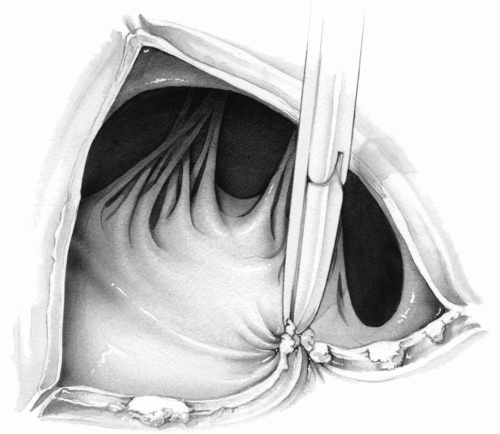 FIG 5-8. Injudicious pulling on the calcium embedded in the aortic annulus, creating a defect through the aortic root to other chambers of the heart or the pericardium (see Fig. 5-4). |
Aggressive pulling on the calcium while attempting to remove it from the aortic annulus may occasionally weaken an area, which can result in perforation either outside the heart or into the other chambers of the heart. The weakened area must be recognized and approximated with pledgeted sutures (Fig. 5-9).
Sizing the Aortic Prosthesis
The prosthesis chosen for replacement of the aortic valve must fit snugly in the annulus. Three simple sutures are inserted, one in each commissure (Fig. 5-10A) or in the annulus near each commissure (Fig. 5-10B). The aortic orifice can be opened by applying traction to these three sutures. At times, sutures placed in the nadir of the annulus between the commissures will open the left ventricular outflow tract more optimally, making sizing easier (Fig. 5-10C). Differently sized obturators are then serially introduced into the annulus, starting with the smallest one. The correctly sized prosthesis is therefore selected.
A very loose fit indicates that the patient will not benefit from the largest possible prosthesis, which will have the optimal hemodynamics.
A tight fit may make satisfactory seating of the prosthesis difficult. Oversizing the prosthesis may cause disruption of the aortic annulus and/or make closure of the aortotomy difficult.
Because the sizers are exact replicas of the respective prostheses, the annulus must be measured with the sizer that corresponds to the specific prosthesis. This is particularly relevant when using a prosthesis designed for supraannular implantation.
It is important to consider the left ventricular outflow tract, aortic annulus, and sinotubular junction when sizing for an appropriate prosthesis. This may not be of much significance in patients with pure aortic insufficiency. However, in patients with severe aortic stenosis, there may be left ventricular outflow tract narrowing owing to septal hypertrophy. The poststenotic dilation may sometimes obscure or distort the sinotubular junction. Therefore, the diameter at each level may be different, making sizing for an appropriate prosthesis somewhat demanding. It is prudent to attempt to size the left ventricular outflow tract, aortic annulus, and sinotubular junction separately so that an appropriate type of prosthesis can be selected.
When the aortic root is heavily calcified or there are calcific ridges in the wall of the aorta, it may be difficult to introduce the sizer into the aortic root. The surgeon must then visually judge the size of the prosthesis.
Often there is calcification in the aortic root involving the sinuses and extending into the coronary artery ostia. With experience, it is possible to decalcify the aortic root wall in specific locations to facilitate implantation of an appropriately-sized prosthesis. The technique consists of gently crushing segments of calcified intima with a rongeur and then removing them from the aortic wall to facilitate the surgery. Implantation of a stentless aortic bioprosthesis or a homograft using a modified subcoronary technique will reinforce a weakened segment of the aortic wall.
It is important not to pull away calcified segments from the wall of the aortic root in order to prevent a buttonhole injury. The connection of the calcified segment with the intima must be sharply divided with scissors.
Technique for Suture Insertion
The prosthesis is sewn into position with interrupted sutures such as 2-0 Tevdek or Ticron, double-armed with tapered needles. A deep bite of the annulus is taken. The suture ends are then either held taut by an assistant or inserted in the correct order into a circular ring (Fig. 5-11). When all the annular sutures have been placed, they are passed through the sewing ring of the prosthesis in an orderly manner, either singly or in a vertical mattress technique. Alternatively, each suture can be passed through the annulus and the valve-sewing ring in one step (Fig. 5-12). Sometimes certain segments of the annulus are not in full view. Pulling on a previously placed suture will improve the exposure (Fig. 5-13). This suture can be held taut, either by the surgeon’s hand or by placing it in the circular ring.
The tip of the suture needle can be used to dislodge calcium particles deeply embedded in the myocardium (Fig. 5-14).
The sutures must be individually tested to make certain that they include a good, secure bite of the annulus; they may tear through if they include only degenerative leaflet tissue or a narrow rim of the annulus. If the suture appears to be insecure, it is either removed or converted to a figure-of-eight stitch (Fig. 5-15) and then passed through the sewing ring of the prosthesis in a horizontal mattress fashion.
When the annulus is calcified or too friable to hold sutures securely, pledgeted sutures (2-0 Ethibond or Ticron) are satisfactory alternatives. It is technically
easier to insert the sutures in an everted manner, with the pledgets lying above the annulus in the aorta (Fig. 5-16A). The alternative technique of placing sutures from below, which allows the pledgets to remain subannular, provides a secure and satisfactory buttressing effect (Fig. 5-16C). This technique is used for supraannular insertion of a prosthetic valve. If utilized with a disc valve, the surgeon must ensure that no pledgets interfere with the normal movement of the disc. Also, if a suture breaks while being tied, the loose pledget must be retrieved. The prosthesis often must be removed in order to locate and remove the loose pledget from the left ventricle. Whether the pledgeted sutures are placed from below or above the annulus, they are inserted into the sewing ring of the prothesis in a horizontal mattress fashion (Fig. 5-17). The routine use of pledgets has markedly reduced the occurrence of paravalvular leaks.
easier to insert the sutures in an everted manner, with the pledgets lying above the annulus in the aorta (Fig. 5-16A). The alternative technique of placing sutures from below, which allows the pledgets to remain subannular, provides a secure and satisfactory buttressing effect (Fig. 5-16C). This technique is used for supraannular insertion of a prosthetic valve. If utilized with a disc valve, the surgeon must ensure that no pledgets interfere with the normal movement of the disc. Also, if a suture breaks while being tied, the loose pledget must be retrieved. The prosthesis often must be removed in order to locate and remove the loose pledget from the left ventricle. Whether the pledgeted sutures are placed from below or above the annulus, they are inserted into the sewing ring of the prothesis in a horizontal mattress fashion (Fig. 5-17). The routine use of pledgets has markedly reduced the occurrence of paravalvular leaks.
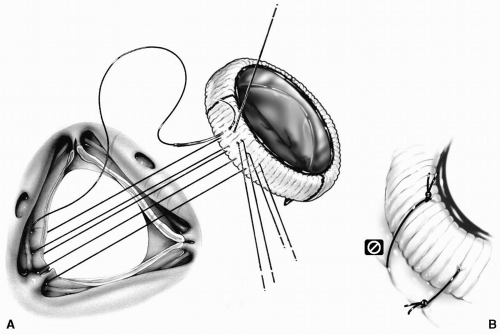 FIG 5-12. A: Passing sutures directly from the annulus to the prosthetic sewing ring. B: Proper placement of sutures in the sewing ring to place the knot away from the valve itself. |
Deeply placed sutures near the noncoronary and right coronary annuli can injure the conduction tissues and give rise to various forms of heart block (Fig. 5-18). When there is massive calcification extending onto the ventricular septum or when the tissues are friable because of endocarditis or abscess formation, this complication may be inevitable. Temporary ventricular wires are recommended for all patients undergoing aortic valve surgery. If the patient is still in complete heart block at the completion of the procedure, temporary atrial wires should be placed to allow for atrioventricular sequential pacing. A permanent pacemaker may need to be implanted before the
patient’s discharge if atrioventricular conduction has not been reestablished.
patient’s discharge if atrioventricular conduction has not been reestablished.
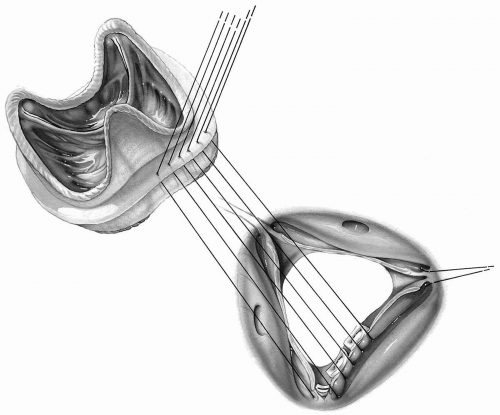 FIG 5-17. Horizontal mattress sutures, with pledgets below the annuli, placed in a horizontal mattress fashion in the prosthetic ring. |
The precise site of suture placement in the aortic annulus is often obscured by pathologic changes, calcifications, and deformities. Deep sutures placed near the left coronary annulus may puncture the left main coronary artery as it passes behind the aortic root (Fig. 5-19). This is indeed a very grave error, and the surgeon must always be sensitive to this possibility and take every precaution to avoid its occurrence. To prevent myocardial ischemia and injury, the suture needs to be immediately removed. If the structural or functional integrity of the left main coronary artery is in any way jeopardized, bypass grafting of all its major branches must be performed.
Tissue prostheses tend to lose moisture when in a dry field, a process accelerated by heat generated from the operating room overhead lights. The valvular tissue will be permanently damaged, which may result in premature prosthetic failure. As a precaution, the prosthesis must be kept moist by intermittently rinsing it with normal saline solution at room temperature.
Suture needles are passed through the prosthetic sewing ring from below upward, with the needle exiting at the junction of the outside half with the inside half of the sewing ring (Fig. 5-12B). Sutures placed in such a manner in the sewing ring of a bioprosthesis are well away from the tissue-sewing ring interface and avoid traumatizing or perforating the tissue leaflets. Similarly, the suture knots will face away from the orifice of a mechanical valve, preventing contact with the disc or leaflets.
Before placing sutures in the prosthesis, every precaution should be taken to ensure that the tissue prosthesis is oriented so that the struts do not obstruct the coronary artery ostia.
Seating the Prosthesis
When all sutures have been accurately placed in the sewing ring, the prosthesis is gently lowered and fitted snugly in the annulus. Many surgeons rinse the sutures with saline solution for its lubricating effect, allowing the sutures to be pulled through the sewing ring more smoothly.
When the sinotubular junction of the ascending aorta is narrower than the aortic annulus, the appropriate size prosthesis will be too large to pass through it. In such situations, the holder is removed and the prosthetic low-profile valve is turned on end, then lowered and seated safely in the aortic annulus (Fig. 5-20).
Antibiotics or other chemical solutions may react with glutaraldehyde and produce irreversible damage to the tissue prosthesis. Therefore, these valves should be rinsed only with room temperature physiologic saline solution.
Some tissue prostheses have flexible rings. The surgeon should not attempt to manipulate and force a large prosthesis into a relatively small aortic annulus because this may distort the flexible ring and the valve leaflets causing incompetence.
No redundant tissue fragment, calcium, or subannular pledgets should protrude into the left ventricular outflow tract in such a way as to prevent satisfactory opening and closing of the valve (Fig. 5-21). Normal valve function must be ensured and any obstructing element removed before final anchoring of the prosthesis.
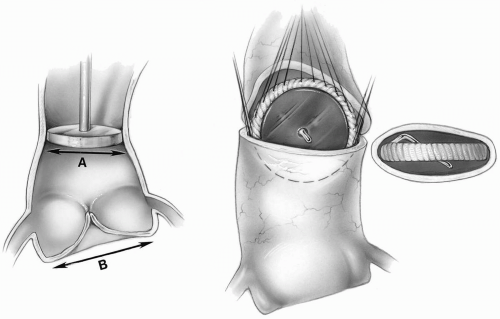 FIG 5-20. Technique for implantation of the optimal size prosthesis through a narrow ascending aorta. A: Sinotubular diameter. B: Annular diameter. |
After the prosthesis has been satisfactorily seated, the sutures are tied down securely and cut short.
Stay updated, free articles. Join our Telegram channel

Full access? Get Clinical Tree


